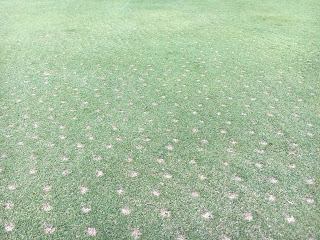There are many factors that influence ball speed on putting greens. At any given time one factor can have a greater influence than another, and then in a short amount of time, the impact could reverse, or change entirely. As a golf course superintendent, I have control over a few of the factors. I can influence a few other, and some of them I have zero influence on.

First, let me talk about the ones that I have control over. Mowing height, and frequency, rolling frequency, topdressing, and irrigation are the things that are on this list. I choose to maintain my mowing height at the same height all year long. we cut our greens at .125" (1/8 inch). I have found over the years, that this is a pretty reasonable height to maintain the health of these greens year round. The frequency of mowing will change based on the growth rate of the grass. If the greens are growing rapidly, we may need to mow every day. During the winter months, we might not cut them for weeks or even months. During an average week in the spring, summer, and fall, we will alternate days with mowing and rolling. Topdressing and irrigation are done on an as needed basis. The weather, and growth rate of the turf impact the amount and frequency of these practices.
Second, let me talk about the factors that I can influence. Fertility, and growth rate, fall into this category. I can influence these things chemically. I can apply more fertilizer, using quickly available sources or slowly available sources. Generally I like to fertilize my greens frequently, using a very light rate, of a predictably releasing product. This is called "spoon feeding." This helps to maintain a healthy growth rate without starving the turf or causing it to grow rapidly. I can influence the growth rate chemically as well. Plant growth regulators are somewhat effective, and somewhat predictable in slowing down the growth rate of grass. These products are used when factors that I have no control over begin to have too much influence. Generally a growth regulator will not speed up ball roll, but rather keep it more consistent from morning until evening.
Lastly are the things that I have zero control over. Air temperature, soil temperature, rainfall, sun angle, day length, humidity, and clouds are the most important factors that I cannot control or influence. This is the longest list, and frequently, one or more of these factors has the greatest influence on your green speed from one day to the next. On any given day, rainfall, high humidity, clouds, and low air temperature can slow down the speed of the greens. Just the same, no rain, low humidity, and high temperatures on a sunny day can speed up the greens. Day length and sun angle speed up the greens, every year in late September. In June and July, when the soil temperatures are highest, soil microbes become active and release nutrients locked up in the soil, and the resulting turf growth, slows down the ball roll.
The bottom line to all of this is that any golf course superintendent, has a limited ability to significantly control the speed of their greens. The work that we do on our greens from day to day remains pretty consistent. The factors that we have zero control over, can play a very big roll in changing the speed of the greens on any given day.
On a lighter note, I hope that all of you home lawners have applied your spring pre-emergent herbicide to control crabgrass and goosegrass. If you haven't, feel free to talk to me. There is still an option that can be used in the next two weeks that will provide good results.














